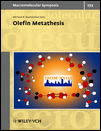Ring-Opening Metathesis Polymerization of Cyclooctyne Employing Well-Defined Tungsten Alkylidyne Complexes
Abstract
Summary: The ring-opening metathesis polymerization of cyclooctyne was studied was studied in the presence of catalytic amounts of the tungsten alkylidyne complexes [RCW(NImtBu){OCMe(CF3)2}2] (1a: R = CMe3, 1b: R = Ph). The resulting polymers show relatively narrow polydispersities with the PDI ranging from 1.2 to 2.4. Treatment of 1b with cyclooctyne in dilute toluene or hexane solution afforded only low molecular weight oligomers. The mass spectra of these oligomers indicate the existence of macrocycles of the formula [C(CH2)6C]n (n = 3–9). In contrast, reactions at high substrate concentration led to mixtures of cyclic oligomers and linear polymers, which is probably a result of ring-chain equilibria, established in agreement with the Jacobson-Stockmayer theory of macrocyclization. In contrast, treatment of neat cyclooctyne with a catalytic amount of the catalyst produced medium molecular weight polymers in good yields.




